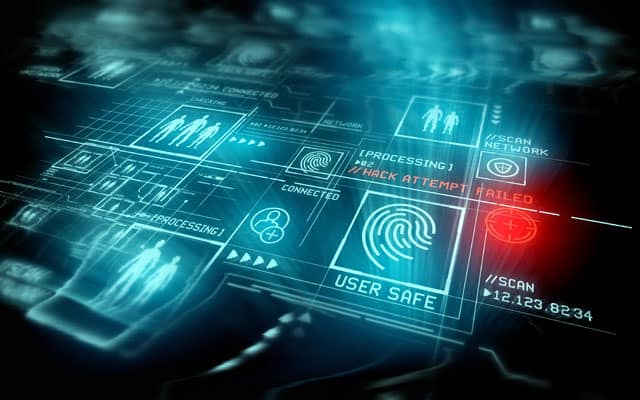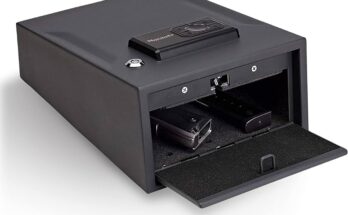As our lives move increasingly online, so do our valuables. Our banking information, social media accounts and other sensitive data are all stored digitally. So it’s no surprise that people are looking for ways to protect their belongings by storing them in biometric safes.
But can these safes really be hacked? It’s a common misconception that biometric safes are impenetrable. Just because they use fingerprint or iris recognition doesn’t mean they can’t be breached.
In fact, any safe – whether it’s a traditional key-locked safe or a biometric one – can be hacked if the right tools and techniques are used.
“No safe is foolproof, but a biometric safe comes pretty close. Biometric safes use your fingerprint as the key to open them, so unless someone has your fingerprint, they’re not getting in. That said, there are ways to hack biometric safes. One method is called “spoofing.” This involves creating a fake fingerprint that tricks the sensor into thinking it’s the real thing. While this sounds complicated, it’s actually not that hard to do.”
All you need is some play-doh and a printer. Another way to hack a biometric safe is by using a laser pointer. By shining the laser on the sensor, you can trick it into thinking there’s a finger present and unlock the safe.
Of course, these methods are not foolproof either and would likely take some time and effort to pull off successfully. So while your biometric safe may not be 100% secure, it’s still much safer than a traditional keyed or combination lock safe.
Video: Biometric “Security” Is NOT Secure
Are Biometrics Immune to Hackers?
No, biometrics are not immune to hackers. In fact, biometrics are often seen as being more vulnerable to hacking than other forms of authentication, such as passwords or PIN numbers. This is because biometric data is unique to each individual and cannot be changed if it is compromised.
Once a hacker has access to your biometric data, they can use it to impersonate you and gain access to your accounts or sensitive information. There have been a number of high-profile cases of biometric data being hacked in recent years. In 2015, the US Office of Personnel Management was breached, resulting in the theft of over 21 million fingerprints.
In 2016, a German company called BioMetric Intelligence was hacked, leading to the leak of over 27 million records containing fingerprint and iris scans. And just last year, a major security flaw was discovered in Samsung’s Galaxy S8 smartphone that allowed anyone with a simple scanning tool to bypass the iris scanner and unlock the device. While these incidents are certainly cause for concern, it’s important to remember that no technology is completely secure from attack.
The best way to protect yourself from having your biometric data compromised is to be aware of the risks and take steps to reduce your exposure. For example, only store your biometric data on devices that are encrypted and protected by strong passwords or passcodes. And be sure to keep your software up-to-date so that you can benefit from the latest security enhancements.
How Safe is Biometric Security?
There is no doubt that biometric security is one of the most secure ways to protect your data. After all, it relies on physical characteristics that are unique to each individual, making it virtually impossible for someone to gain access to your information without your permission. That said, nothing is 100% foolproof and there have been some concerns raised about the safety of biometric security.
For example, in 2017 a group of researchers were able to create fake fingerprints that could bypass certain types of biometric security systems. However, it’s important to remember that these types of attacks are still relatively rare and that the vast majority of people who use biometric security systems never experience any problems. Plus, as technology continues to evolve, it’s likely that any weaknesses in current biometric security systems will be addressed and corrected.
Overall, while there are always risks associated with any type of security system, biometric security remains one of the safest and most effective ways to protect your data.
Can Biometric Attributes Be Stolen?
There is a lot of debate surrounding whether or not biometric attributes can be stolen. Some people believe that biometric data is more secure than traditional methods like passwords, while others believe that biometrics are actually easier to steal than other types of data. So, what’s the truth?
Can biometric attributes be stolen? The answer is… it depends. Biometric data can be more difficult to steal than other types of data, but it’s not impossible.
In fact, there have been several high-profile cases where biometric data has been successfully stolen. One notable example occurred in 2017, when a hacker used a phishing attack to steal the thumbprint of a German politician. The politician had stored her thumbprint on her smartphone in order to use it as a form of authentication.
However, the hacker was able to trick her into installing a malicious app that gave him access to her thumbprint. He then used the thumbprint to unlock her phone and gain access to sensitive information. Another example happened in 2018, when hackers were able to steal over 1 million fingerprint records from a Vietnamese company called Suprema.
The hackers gained access to Suprema’s database by exploiting a vulnerability in their system. Once they had access, they were able copy all of the fingerprint records stored inside. These examples show that it is possible for biometric data to be stolen.
However, it’s important to keep in mind that these incidents are relatively rare compared to other forms of data theft (like credit card theft). Additionally, many companies are taking steps to make sure their systems are more secure and less vulnerable to these sorts of attacks.
Is Biometrics Security Safer Than Passwords?
There is no simple answer when it comes to whether biometrics security is safer than passwords. Both have their own advantages and disadvantages that need to be considered. Passwords can be guessed, brute forced, or phished.
They can also be stolen in a data breach. However, if implemented properly, they can still be quite secure. Biometrics, on the other hand, are less vulnerable to guessing and brute forcing but more susceptible to spoofing attacks.
When it comes down to it, the best way to determine which is more secure for you is to consider your specific needs and threat model. If you’re concerned about someone stealing your password or using it to gain access to your accounts, then biometrics may be a better option. But if you’re worried about someone being able to spoof your biometric data, then a password might be a better choice.

How to Bypass Biometric Authentication
Most of us are familiar with biometric authentication methods like fingerprint scanners and iris recognition. But did you know that there are ways to bypass these security measures? In this blog post, we’ll explore how to bypass biometric authentication, so that you can be aware of the potential risks.
One way to bypass biometric authentication is through the use of a fake finger or iris. This can be made from materials like latex or Play-Doh, and can fool the sensor into thinking it’s a real finger or iris. Another way to bypass biometric authentication is through the use of a photograph.
This works because some sensors are not sophisticated enough to distinguish between a real finger or iris and a photograph. Of course, there are also more sophisticated ways to bypass biometric authentication. For example, some hackers have used laser pointers to trick fingerprint scanners into thinking they’re scanning a real finger.
Others have used high-resolution cameras to capture an iris image, which can then be used to spoof the authentication system. So what does this mean for you? If you’re using biometric authentication methods, it’s important to be aware of the potential risks.
And if you’re concerned about someone being able to bypass your security measures, you may want to consider using additional security measures, like two-factor authentication.
Conclusion
Yes, biometric safes can be hacked. Here’s how:
1. If the safe is not properly secured, a hacker can simply break in and access the data stored inside.
2. If the safe is connected to the internet, a hacker can remotely access it and extract the data.
3. Hackers can also use malware to infect the safe and gain access to its contents.



